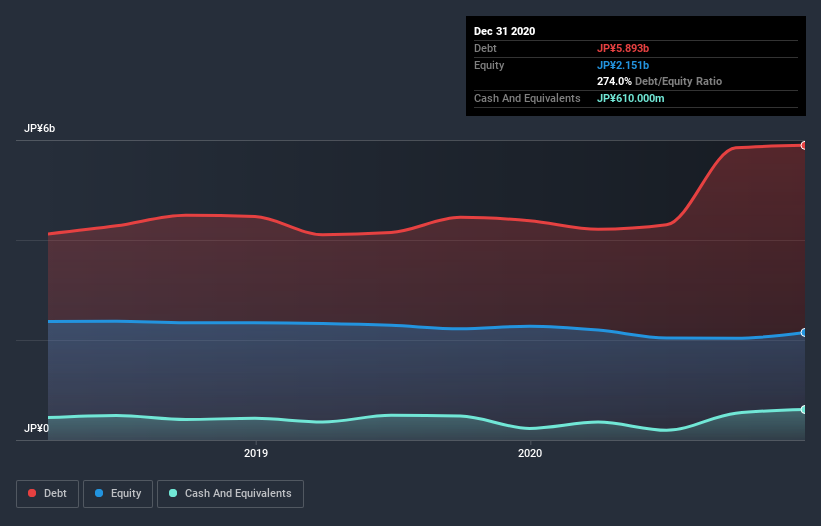OK Food Industry (TYO:2905) Has Debt But No Earnings; Should You Worry?

Warren Buffett famously said, 'Volatility is far from synonymous with risk.' When we think about how risky a company is, we always like to look at its use of debt, since debt overload can lead to ruin. We can see that OK Food Industry Co., Ltd. (TYO:2905) does use debt in its business. But the more important question is: how much risk is that debt creating?
Why Does Debt Bring Risk?
Debt and other liabilities become risky for a business when it cannot easily fulfill those obligations, either with free cash flow or by raising capital at an attractive price. Part and parcel of capitalism is the process of 'creative destruction' where failed businesses are mercilessly liquidated by their bankers. However, a more usual (but still expensive) situation is where a company must dilute shareholders at a cheap share price simply to get debt under control. Of course, the upside of debt is that it often represents cheap capital, especially when it replaces dilution in a company with the ability to reinvest at high rates of return. The first thing to do when considering how much debt a business uses is to look at its cash and debt together.
Check out our latest analysis for OK Food Industry
What Is OK Food Industry's Debt?
You can click the graphic below for the historical numbers, but it shows that as of December 2020 OK Food Industry had JP¥5.76b of debt, an increase on JP¥4.39b, over one year. However, it does have JP¥610.0m in cash offsetting this, leading to net debt of about JP¥5.15b.

How Strong Is OK Food Industry's Balance Sheet?
The latest balance sheet data shows that OK Food Industry had liabilities of JP¥4.19b due within a year, and liabilities of JP¥3.60b falling due after that. On the other hand, it had cash of JP¥610.0m and JP¥1.50b worth of receivables due within a year. So its liabilities outweigh the sum of its cash and (near-term) receivables by JP¥5.69b.
Given this deficit is actually higher than the company's market capitalization of JP¥4.32b, we think shareholders really should watch OK Food Industry's debt levels, like a parent watching their child ride a bike for the first time. Hypothetically, extremely heavy dilution would be required if the company were forced to pay down its liabilities by raising capital at the current share price. When analysing debt levels, the balance sheet is the obvious place to start. But you can't view debt in total isolation; since OK Food Industry will need earnings to service that debt. So if you're keen to discover more about its earnings, it might be worth checking out this graph of its long term earnings trend.
Over 12 months, OK Food Industry made a loss at the EBIT level, and saw its revenue drop to JP¥8.1b, which is a fall of 14%. That's not what we would hope to see.
Caveat Emptor
Not only did OK Food Industry's revenue slip over the last twelve months, but it also produced negative earnings before interest and tax (EBIT). Indeed, it lost JP¥351m at the EBIT level. When we look at that alongside the significant liabilities, we're not particularly confident about the company. It would need to improve its operations quickly for us to be interested in it. Not least because it burned through JP¥1.5b in negative free cash flow over the last year. That means it's on the risky side of things. When analysing debt levels, the balance sheet is the obvious place to start. But ultimately, every company can contain risks that exist outside of the balance sheet. Case in point: We've spotted 3 warning signs for OK Food Industry you should be aware of, and 2 of them are a bit unpleasant.
Of course, if you're the type of investor who prefers buying stocks without the burden of debt, then don't hesitate to discover our exclusive list of net cash growth stocks, today.
If you decide to trade OK Food Industry, use the lowest-cost* platform that is rated #1 Overall by Barron’s, Interactive Brokers. Trade stocks, options, futures, forex, bonds and funds on 135 markets, all from a single integrated account. Promoted
New: AI Stock Screener & Alerts
Our new AI Stock Screener scans the market every day to uncover opportunities.
• Dividend Powerhouses (3%+ Yield)
• Undervalued Small Caps with Insider Buying
• High growth Tech and AI Companies
Or build your own from over 50 metrics.
This article by Simply Wall St is general in nature. It does not constitute a recommendation to buy or sell any stock, and does not take account of your objectives, or your financial situation. We aim to bring you long-term focused analysis driven by fundamental data. Note that our analysis may not factor in the latest price-sensitive company announcements or qualitative material. Simply Wall St has no position in any stocks mentioned.
*Interactive Brokers Rated Lowest Cost Broker by StockBrokers.com Annual Online Review 2020
Have feedback on this article? Concerned about the content? Get in touch with us directly. Alternatively, email editorial-team (at) simplywallst.com.
About TSE:2905
OK Food Industry
OK Food Industry Co., Ltd. produces and sells fried tofu products in Japan.
Overvalued with weak fundamentals.


